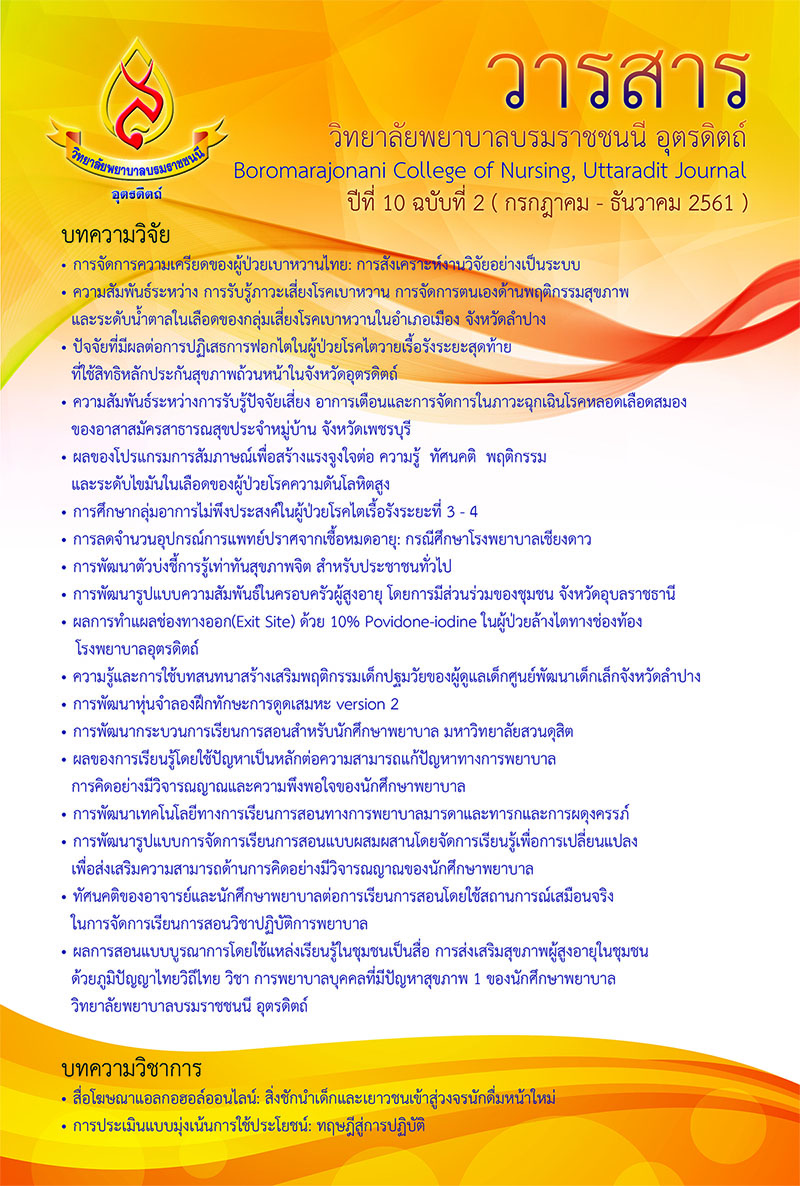การพัฒนารูปแบบความสัมพันธ์ในครอบครัวผู้สูงอายุ โดยการมีส่วนร่วมของชุมชนจังหวัดอุบลราชธานี
Main Article Content
บทคัดย่อ
การวิจัยและพัฒนานี้มีวัตถุประสงค์เพื่อ 1) ศึกษาปรากฏการณ์ความสัมพันธ์ในครอบครัวผู้สูงอายุ ทางเศรษฐกิจ สังคม วัฒนธรรม ประเพณี ความสอดคล้องของคุณลักษณะความสัมพันธ์ในครอบครัวผู้สูงอายุที่พึงประสงค์ สภาพปัญหา และความต้องการพัฒนาความสัมพันธ์ในครอบครัวผู้สูงอายุ 2) พัฒนารูปแบบความสัมพันธ์ในครอบครัวผู้สูงอายุ 3) ทดลองใช้รูปแบบ 4) ประเมินผลรูปแบบความสัมพันธ์ในครอบครัวผู้สูงอายุ กลุ่มตัวอย่างในระยะที่ 1 คือสมาชิกครอบครัวผู้สูงอายุ จำนวน 290 คน และผู้ให้ข้อมูลสัมภาษณ์เชิงลึก จำนวน 10 คน ระยะที่ 2,3 และ 4 กลุ่มตัวอย่างเป็นสมาชิกในครอบครัวจำนวน 40 คน และผู้สูงอายุจำนวน 40 คน และผู้เชี่ยวชาญด้านครอบครัว จำนวน 10 คน เครื่องมือที่ใช้ในการวิจัย ประกอบด้วยแบบสอบถามคุณลักษณะความสัมพันธ์ในครอบครัวผู้สูงอายุที่พึงประสงค์ สภาพปัญหาและความต้องการพัฒนาด้านความสัมพันธ์ในครอบครัวผู้สูงอายุ แบบทดสอบความรู้ แบบสอบถามความคิดเห็นต่อผลที่เกิดขึ้นในการพัฒนารูปแบบ แบบสอบถามความพึงพอใจ และแบบสัมภาษณ์เชิงลึก วิเคราะห์ข้อมูลโดยใช้สถิติร้อยละ ค่าเฉลี่ย ส่วนเบี่ยงเบนมาตรฐาน และสถิติทดสอบที (Dependent t-test) วิเคราะห์ข้อมูลเชิงคุณภาพโดยการวิเคราะห์เนื้อหา
ผลการวิจัยพบว่า ;
1) ปรากฏการณ์ความสัมพันธ์ในครอบครัวผู้สูงอายุพัฒนาการสร้างความสัมพันธ์ให้กับสมาชิกครอบครัว ภาพรวมอยู่ในระดับ มาก รูปแบบการพัฒนาความสัมพันธ์ในครอบครัวผู้สูงอายุโดยการมีส่วนของชุมชน ในจังหวัดอุบลราชธานี ผู้วิจัยประยุกต์ทฤษฎีโครงสร้างครอบครัว (บวร) “BOWARN MODEL” และ Social Support โดย การพัฒนารูปแบบความสัมพันธ์ในครอบครัวผู้สูงอายุ ประกอบด้วย 1) บ้าน 2) วัด 3) โรงเรียน และ 4) ชุมชน เสริมคุณค่าด้วยปรัชญาสุภาษิตผญาพื้นบ้าน มีองค์ประกอบการพัฒนา 3 ด้าน ได้แก่ 1) ด้านการส่งเสริมความเข้มแข็งของครอบครัว 2) ด้านการพัฒนาหน้าที่สมาชิกครอบครัว 3) ด้านการได้รับความช่วยเหลือจากสังคมหรือสังคมมีความเอื้ออาทร
2) สมาชิกครอบครัวผู้สูงอายุมีความรู้เฉลี่ยหลังเข้าร่วมโปรแกรมสูงกว่าก่อนการทดลองอย่างมีนัยสำคัญทางสถิติที่ระดับ .001 (p< .001)
3) การประเมินผลรูปแบบ พบว่า ระดับความคิดเห็นต่อผลที่เกิดขึ้นอยู่ในระดับมากและสมาชิกในครอบครัวและผู้สูงอายุต่อการใช้ความสัมพันธ์ในครอบครัว มีความพึงพอใจอยู่ในระดับมาก
Article Details
บทความหรือข้อคิดเห็นใดใดที่ปรากฏในวารสารวิจัยการพยาบาลและวิทยาศาสตร์สุขภาพ เป็นวรรณกรรมของผู้เขียน ซึ่งบรรณาธิการหรือสมาคมศิษย์เก่า ไม่จำเป็นต้องเห็นด้วย และบทความที่ได้รับการตีพิมพ์เผยแพร่ถือเป็นลิขสิทธิ์ของวารสารวิจัยการพยาบาลและวิทยาศาสตร์สุขภาพ
เอกสารอ้างอิง
2. Srisa-ard, B. (2010). Preliminary research. (8 thed.) . Bangkok: Suviraya message service. (in Thai)
3. Chao, S., Lan, Y., Tso, H., Chung, C., Neim, Y., & Clark, M.J. (2008). Predictors of psychosocial adaptation among elderly residents in long -term care settings. Journal of Nursing Research, 16(2),149-158.
4. Frison, L., & Procock, SJ. (1992). Repeated Measure in Medical Trials : Analysis using mean summary statistics and its implications for designs. Statistics in Medicine.1, 1685 –1704.
5. Friedman, M.M. (1986). Family nursing: Theory and assessment (2 nd). New York: Appleton-Contury - Crofts.
6. Keeves, J. (1997). Education research, methodology and measurement: An International Handbook .(2 nd ed). Oxford: Pergamon.
7. Krejcie, R.V. & Morgan, D.W., (1970). “Determining Sample Size for Research Activities”. Educational and Psychological Measurement, 30(3), 607-610.
8. Manorath, P. (2013). Older Alone : Impact and Social role on care. Boromarajonani College of Nursing, Uttaradit Journal, 5(2), 98-102 (in Thai)
9. National Elderly Committee. (2010). The National Elderly Development Plan No. (2002-2022). Bangkok: Thep-phen-vanish -printing house. (in Thai)
10. National Health Security Office. (2016). Long-term Care Guide for Public Health Care for The Elderly with dependent area in the National Health Security System, fiscal year 2016. Bangkok: National Health Security Office. (in Thai)
11. National Institute of Development Administration. (2010, March 15). Older people want their children to visitrather than make money. (Transparency Thailand). https://www.nida.ac.th/thai/web/ (in Thai)
12. National Institute for Child and Family Development. (2012 March 15). Knowledge for life, caring Child protection Mahidol University.https://w.w.w. factsforlifethai.cf.mahidol.ac.th/protect ion/support01.php (in Thai)
13. National Statistical Office. (2012). Summary for Management System for Health and Welfare Survey 2012. Bangkok: Director Statistical Forecasting Bureau. (in Thai)
14. Podhisita, C.&Thavesit, S., (2009). Population and society thai families in social and demographic transition. Nakhonpathom:Company duentula-printing house. (in Thai)
15. Ratanawong, C., Khamkhard, U., & Manorath, P. (2013). Problems, Needo and Quality of life for Elderly Prisoners. A Case Study at Uttaradit Prison. Boromarajonani College of Nursing, Uttaradit Journal. 4(2), 25-32 (in Thai)
16. Robrujen, S. (2017). Development of the Elderly Care Model for Elderly Caregivers, Warinchamrab District UbonRatchathani Province. Princess of Naradhiwas University Journal, 9(3), 108-120. (in Thai)
17. Srijukkot, J. (2007) . Provision Care for the Elderly: Case Study in-I-san Cultural Context. Doctor of Philosophy Thesis in Nursing,Graduate School, Khon Kaen University. (in Thai)
18. Suree, J. (2000). Health strategies. (3rd edition). Bangkok: Charoen Wit printing. (in Thai).
19. Thammaaphiphol, K., Soonthornthada, k.,Pornsiripongse, S., Wirojratana, V., Winichagoon, P., Srisupan, W., et al. (2014). Participatory Action Research on the Holistic Care Model for the Elderly. Journal of Health System Research, 8(2). 120-131. (in Thai)
20. Yodpet, S. (2009). Integrated long-term care system for thai elderly. Bangkok: J-print-2. (in Thai)
21. United Nations. (2006). We the people : the role of the United Nations in the twenty-first century: the millennium report. New York: United Nations.


